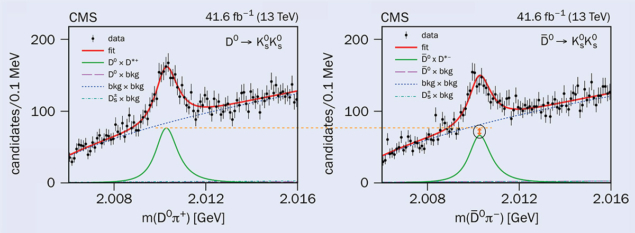A report from the CMS experiment.

The high data rate at the LHC creates challenges as well as opportunities. Great care is required to identify interesting events, as only a tiny fraction can trigger the detector’s readout. With the LHC achieving record-breaking instantaneous luminosity, the CMS collaboration has innovated to protect and expand its flavour-physics programme, which studies rare decays and subtle differences between particles containing beauty and charm quarks. Enhancements in the CMS data-taking strategy such as “data parking” have enabled the detector to surpass its initial performance limits. This has led to notable advances in charm physics, including CMS’s first analysis of CP violation in the charm sector and achieving world-leading sensitivity to the rare decay of the D0 meson into a pair of muons.
Data parking stores subsets of unprocessed data that cannot be processed promptly due to computing limitations. By parking events triggered by a single muon, CMS collected an inclusive sample of approximately 10 billion b-hadrons in 2018. This sample allowed CMS to reconstruct D0 and D0 decays into a pair of long-lived K0s mesons, which are relatively easy to detect in the CMS detector despite the high level of pileup and the large number of low-momentum tracks.
CP violation is necessary to explain the matter–antimatter asymmetry observed in the universe, but the magnitude of CP violation from known sources is insufficient. Charmed meson decays are the only meson decays involving an up-type quark where CP violation can be studied. CP violation would be evident if the decay rates for D0 → K0s K0s and D0 → K0s K0s were found to differ. In the analysis, the flavour of the initial D0 or D0 meson is determined from the charge of the pion accompanying its creation in the decay of a D*+ meson (see figure 1). To eliminate systematic effects arising from the charge asymmetry in production and detector response, the CP asymmetry is measured relative to that in D0 → K0s π+π–. The resulting asymmetry is found to be ACP(KSKS) = 6.2% ± 3.0% (stat) ± 0.2% (syst) ± 0.8% (PDG), consistent with no CP violation within 2.0 standard deviations. Previous analyses by LHCb and Belle were consistent with no CP violation within 2.7 and 1.8 standard deviations, respectively. Before data parking, searching for direct CP violation in the charm sector with a fully hadronic final state was deemed unattainable for CMS.
The CMS collaboration has expanded its flavour-physics programme
For Run 3 the programme was enhanced by introducing an inclusive dimuon trigger covering the low mass range up to 8.5 GeV. With improvements in the CMS Tier-0 prompt reconstruction workflow, Run-3 parking data is now reconstructed without delay using the former Run-2 high-level trigger farm at LHC Point 5 and European Tier-1 resources. In 2024 CMS is collecting data at rates seven times higher than the nominal rates for Run 2, already reaching approximately 70% of the nominal trigger rate for the HL-LHC.
Using the data collected in 2022 and 2023, CMS performed a search for the rare D0-meson decay into a pair of muons, which was presented at the ICHEP conference in Prague. Rare decays of the charm quark, less explored compared to those of the bottom quark, offer an opportunity to probe new physics effects beyond the direct reach of current colliders, thanks to possible quantum interference by unknown heavy virtual particles. In 2023, the LHCb collaboration set an upper limit for the branching ratio at 3.5 × 10–9 at a 95% confidence using Run-2 data. CMS surpassed the LHCb result, achieving a sensitivity of 2.6 × 10–9 at a 95% confidence. Given that the Standard Model prediction is four orders of magnitude smaller, there is still considerable territory to explore.
Beginning with the 2024 run, the CMS flavour-physics programme will gain an additional data stream known as data scouting. This stream captures at very high-rate events triggered by new high-purity single muon level-one triggers in a reduced format. This format is suitable for reconstructing decays of heavy hadrons, offering performance comparable to standard data processing.
Further reading
CMS Collab. 2024 arXiv:2403.16134.
CMS Collab. 2024 arXiv:2405.11606.
CMS Collab. 2024 CMS-PAS-BPH-23-008.







